9 Most Important Subscription Management Software Features
Looking for the best subscription management software features to find the right solution for your business? Read this post to find nine must-have features.

This post was last updated on January 27, 2025
Jump to read
What is Subscription Management Software?
Why Should You Invest in a Subscription Management Software Solution?
What are the Most Important Subscription Management Software Features?
FAQs
Conclusion
The global subscription economy is growing rapidly and is expected to reach $996 billion by 2028, from $593 billion in 2024.
That’s one of the reasons why so many businesses are shifting to the subscription business model.
This calls for the need for good subscription management software with features that can help manage all aspects of a subscription business.
What are the most important subscription management software features?
Well, you’ll find out soon enough. In this post, we’ve compiled a list of must-have subscription management software features that you should consider before making a purchase.
But, before that, let’s first understand what a subscription management system is and why it’s needed.
You May Also Like:
- Use a Subscription Management Solution as the Foundation for Your SaaS Metrics
- How to Streamline Financial Processes with Subscription Billing Platforms
What is Subscription Management Software?
A subscription management software solution helps SaaS businesses optimise and automate their invoicing, billing, payments, revenue recognition, etc.
Subscription businesses earn recurring revenue that is often different for different customers and can change mid-cycle. Given the complexity of the subscription billing model, there are multiple scenarios where a CRM, regular accounting, or invoicing solution will fail.
Subscription management software solutions are designed specifically for such businesses and offer specific features to tackle these complex scenarios.
What are the most important subscription management software features?
We’ll discuss that in a later section. First, let’s discuss why you need a subscription management software solution to begin with.
You May Also Like:
- A Tactical Buyer's Guide for Subscription Management Solutions
- Reasons to invest in a B2B subscription management hub
Why Should You Invest in a Subscription Management Software Solution?
Before we discuss the key subscription management software features you should consider, let’s first understand why you need a solution to manage your subscription business.
Here are some of the key benefits of using a subscription management software solution.
Higher Efficiency and Productivity
Good B2B subscription management platforms allow you to automate routine, yet complex, tasks like invoicing and billing. When done manually, these are prone to error and take a lot of time.
Using a great platform can help you save that time and avoid errors to achieve higher productivity and efficiency.
This is one of the key reasons for investing in a B2B subscription management hub.
This is why automation is one of the most important subscription management software features you should consider.
Improved Customer Experience
These B2B SaaS subscription management software solutions streamline various aspects of managing a subscription billing business model. They allow your business to run smoothly, without hiccups.
Subscription billing software solutions automatically calculate taxes, generate invoices, send payment reminders, and more. This delivers an exceptional customer experience as there are no unnecessary delays or manual errors.
Customers choose a subscription model for the convenience it offers. However, you need a good tool to ensure the model functions smoothly to offer that convenient and hassle-free experience.
Automation, flexible billing, and in-depth analytics are some of the subscription management software features that can help you with this.
You May Also Like:
- Why prioritising customer experience can improve USPs
- How to create more personalised experiences for customers
Regulatory Compliance and Security
If you run an international business, it’s important to comply with local regulations and tax laws. Using the best subscription management software platform you can achieve that as it will automatically calculate taxes and comply with rules. Managing customer data securely is a core responsibility for any subscription business, which is why many companies rely on an up-to-date guide to help them identify vulnerabilities and protect sensitive information across devices and storage systems. Following a clear, step-by-step guide not only helps teams maintain compliance but also reduces the risk of disruptions caused by corrupted files or malicious software—especially on removable media like SD cards, where hidden threats can easily go unnoticed.
Moreover, most subscription management platforms have built-in security features to protect customer data. So, using one you can ensure customer data security.
Look for subscription management software features like automatic tax calculation and tax compliance to ensure your company complies with regulations.
Comprehensive Analytics and Reporting
Tracking the key performance metrics is important for any business. With the right subscription management software solution, you can track your SaaS metrics and identify trends and potential issues.
These insights can also help you in doing a churn analysis to understand the reason customers churn or the point in their journey when they’re most likely to churn.
With this, you can take corrective action to reduce churn.
Here are some more benefits of SaaS analytics, which make it one of the most important subscription management software features.

- It gives you insights into how your product is performing and which features customers use the most.
- SaaS metrics give you insights into different aspects of your business to help you make strategic business decisions to improve your product and customer experience.
- By evaluating support tickets and product usage data you can understand customers’s key pain points and improve their experience.
- Tools that use AI-powered analytics can do accurate churn analysis to not only understand the causes of churn but also predict its likelihood. This allows you to take proactive measures to reduce churn.
- Lastly, comprehensive and real-time analytics can help you make quick decisions and pivot to always stay one step ahead of the competition.
You May Also Like:
- Top productivity solutions for subscription businesses
- How to find productivity roadblocks in subscription business
Higher Scalability
Lastly, using a subscription management software solution that can tackle your growing business needs helps you scale faster.
This would be extremely difficult to manage, without a proper tool to handle the complex revenue recognition and billing scenarios of a subscription business.
The key is to choose the right tool that offers tiered plans or the flexibility to increase usage, as required. Compare the subscription management software features for your shortlisted options to make this choice.
You May Also Like:
- Top productivity solutions for subscription businesses
- How to find productivity roadblocks in subscription business
What are the Most Important Subscription Management Software Features?
Here are the subscription management software features that you should consider when selecting one for your business.
Remember, that most solutions will offer these features, but not necessarily at an advanced level. You need to look in-depth to see exactly what subscription management software features a solution is offering and how it differs from that offered by other software solutions.
Keeping that in mind, let’s get started with our list of top subscription management software features.
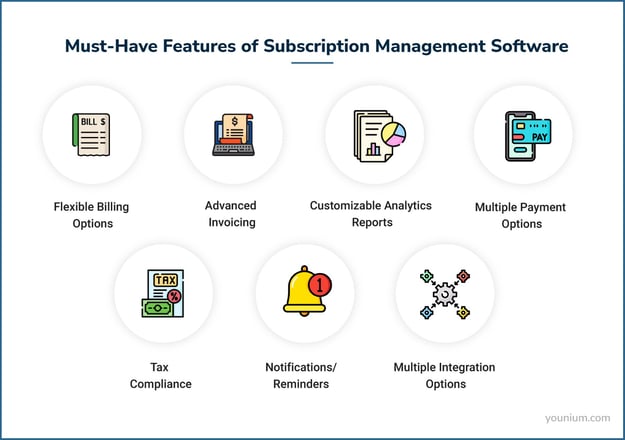
1. Flexible Billing Options
One of the most important subscription management software features is the ability to bill different types of businesses and business plans.
Subscription businesses work on different pricing models, provide different billing schedules to different customers, and have a lot of other complex billing scenarios.
Billing for subscription businesses, therefore, is not as simple as a one-time payment for a good or service.
Additionally, subscription businesses earn recurring revenue, so SaaS subscription management software should provide an automated recurring billing option.
What’s that?
It should be able to automatically bill customers on specific dates, according to their plan and payment schedule.
Seems complicated?
Imagine how much more complicated it would be if you need to keep track of this instead of your subscription management solution.
Let’s discuss the different pricing models and scenarios that good SaaS subscription management software should be able to handle. This will help you identify the subscription management software features that can help you handle all these scenarios.
Ability to Adapt to Different Pricing Models
Subscription businesses use various pricing models for their plans, depending on their industry and specific business requirements. Some offer tiered pricing, while others use usage-based pricing.
Some have even started adopting hybrid pricing where they combine two different pricing models to offer greater flexibility to customers.
Irrespective of the pricing model you choose, ensure transparent and flexible pricing. Avoid any hidden terms and conditions or hidden charges that may surprise customers and break trust.
Clearly lay down all terms and conditions on your website’s pricing page or other brand materials to ensure complete transparency.
With that said, let’s discuss some common pricing models used by subscription businesses. Choose a software solution that can adapt to all of these.
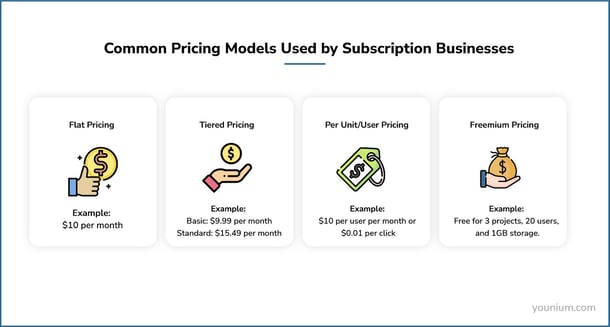
Flat Pricing
A system in which customers pay a flat subscription fee for a specific set of services or features for a given time period. This is different from tiered pricing where the customer can choose among various plans with fixed rates.
Here, there is one all-inclusive plan with a flat fee.
Example: $10 per month
Most B2B SaaS businesses are moving away from this pricing model as it offers no flexibility to customers.
However, you can still use it if you offer a simple, single service for a fixed cost. In this case, there’s no scope for creating tiers as you have just one offering.
Many audiobook or music platforms, for instance, charge a flat monthly fee to give customers unlimited access to their platforms. This is not feasible for B2B SaaS businesses that offer sophisticated platforms with numerous features and functionality.
Tiered Pricing
In this model, customers can choose one out of multiple pricing plans with different sets of features and services. Plans with fewer features will cost less and vice-versa.
Example:
- Basic: $9.99 per month
- Standard: $15.49 per month
Here’s another example where the tiers and features are defined by the end user.

Image via SuperOffice CRM
This is one of the commonly used pricing models for B2B SaaS businesses as it helps them cater to different types of customers. They offer affordable plans with essential features for startups and small businesses and expensive plans with advanced features for large enterprises.
Per Unit/User Pricing
In this case, a business charges customers a fixed amount for every unit or user. So, it’s a usage-based pricing model for which a software solution should be able to track usage and charge accordingly.
Example: $10 per user per month or $0.01 per click
In recent years, many B2B SaaS businesses have made the shift to usage-based pricing as it’s beneficial to both customers and businesses. Customers pay only for what they use, while businesses can charge more for high usage.
Twilio, for example, uses a simple pay-as-you-go pricing model where customers pay only for what they use.

Image via Twilio
Freemium Models
A freemium model offers a free plan with limited features or usage limits. To get access to the complete set of features or increase the usage limit customers need to buy a paid plan.
Example 1: Free for 3 projects, 20 users, and 1GB storage; upgrade to paid plan if you need more.
Example 2: A free forever plan with basic features and paid plans for access to advanced features, such as that offered by Slack.

Image via Slack
Ability to Handle Different Billing Scenarios
One of the crucial SaaS subscription management software features is the ability to make adjustments and perform calculations to accurately bill customers.
There are many scenarios where a customer’s bill amount or schedule would deviate from the normal. Your software solution should be able to adjust for these changes.
Let’s discuss some of these billing scenarios where additional calculations and adjustments may be necessary.
Calendar Billing
Some subscription businesses provide their customers with the option to choose the date on which they want to make their monthly payments. This date may vary from customer to customer.
Good SaaS subscription management software should be able to automatically bill customers on their chosen dates.
This is one of the subscription management software features that are useful for advanced B2B solutions that offer custom contracts to each customer.
Offers & Discounts
Many SaaS businesses offer sales discounts from time to time to attract new customers. Look for a solution that can adjust the current prices and adapt the changed price as and when required.
Also, the discount should automatically reflect on the invoice as well.
Younium, for instance, seamlessly handles various billing scenarios, including temporary offers and discounts. Check out the video below to learn how.
How to manage B2B Subscriptions with (temporary) discounts | Younium Use Case Videos
Grandfathering
Adding to the previous point, your software solution should also be able to charge different prices for the same plan from old and new customers.
Essentially, every customer should pay the price they signed up for when they bought the subscription.
Grandfathering basically allows you to keep existing customers on the same plan, while experimenting with different prices to acquire new customers.
This is one of the most important billing features for a SaaS subscription management software solution.
Mid-Cycle Changes or Prorations
Sometimes customers may change their plan mid-cycle and upgrade or downgrade their plan. Good SaaS subscription management software are capable of recognising these changes and making instant changes to update the bill amount.
Look for subscription management software features that allow automatic invoicing and billing and consolidated invoices.
You May Also Like:
- How to decide on pricing tiers for subscriptions
- Matching pricing arrangements to your subscription contracts
2. Advanced Invoicing
The second on our list of important subscription management software features is invoicing.
While every subscription management solution will have invoicing as a feature, you need to see how basic or advanced their invoicing functionality actually is.
Let’s discuss some of the must-have invoicing features for subscription management software.

Automation
Invoicing automation is one of the most important subscription management software features that streamline financial processes for SaaS businesses.
This feature can help you avoid the hassle of manually generating accurate invoices for each client. Given that different clients may have different plans, payment schedules, and contract terms, manual invoicing is almost always prone to error.
Even if you use a subscription management software system to generate invoices, but need human input, it’s not efficient.
Your subscription management software solution should be able to automatically generate invoices by gathering data from your accounting software.
It should also be able to produce accurate invoices for all the different billing scenarios mentioned above.
Younium, for instance, offers an automatic invoicing feature through integration with Maventa. You can set up each customer’s account details and choose the “Automatic Electronic Routing” option to automatically send e-invoices to customers.
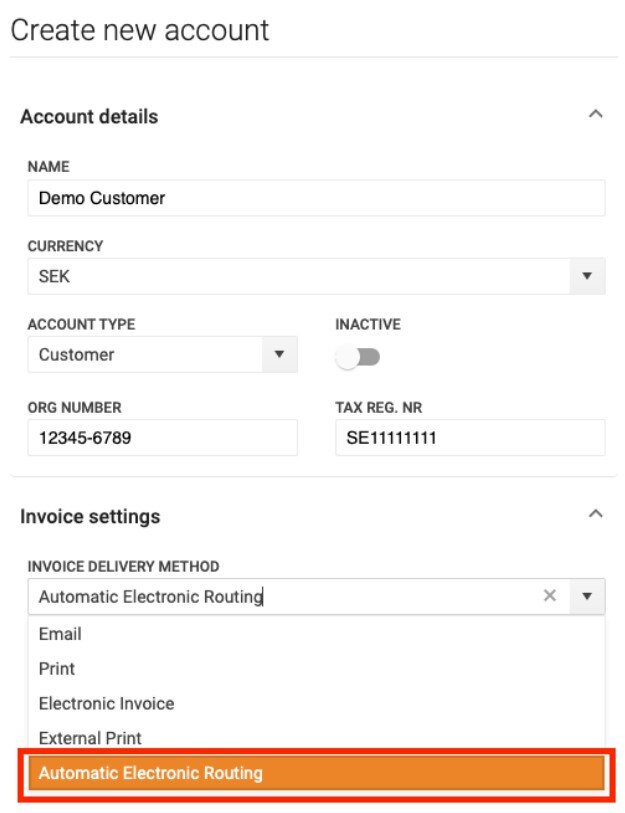
Image via Younium
Customisation
Every business has different requirements for the fields they want on their invoice. It’s not a one-size-fits-all solution.
That’s why one of the subscription management software features you need to look for is customised invoices.
This feature allows you to create customised invoices that include your branding and the fields that are relevant to your business.
Subscription management software solutions like Younium allow different customers to create different invoices. You are not stuck with a default template that you have to use. Apart from the default list of fields, it allows you to create custom fields, offering complete flexibility.
Consolidation
If your business offers multiple types of subscriptions, you need a solution that can consolidate all information for each customer.
So, if a customer makes more than one purchase, you can provide a consolidated invoice. This would include the details of all the subscriptions a customer has purchased from you into a single invoice.
Consolidating multiple invoices into one makes things easier for both the customer and your business.
Younium, for instance, allows you to create consolidated invoices. Here’s a sample invoice with both the monthly subscription fee and a one-off charge.

Image via Younium
This is one of the subscription management software features that optimise financial workflows for SaaS businesses. So, make sure you choose a solution that offers this feature.
Advance Payments
This feature allows you to collect advance payments from customers, instead of billing them on a monthly or quarterly basis.
While it’s simpler to collect a one-time advance payment than charge frequently, not every software solution will provide you with this functionality.
You May Also Like:
- The steps of SaaS success: how to do invoicing right
- What is SaaS Billing? Best Practices and How-To Guide
3. Customisable Analytics Reports
Analytics and reporting are crucial subscription management software features that most platforms offer. However, not all subscription management software will offer advanced customisation options to create targeted reports, even though they may offer basic SaaS reporting tools.
When comparing the analytics features of different software, always check the level of customisation they offer and the depth of subscription insights they provide.
If you can choose which subscription business metrics you can include in your reports and how frequently you want to get an automated report, then there’s nothing like it.
You should also check the kind of visualisation options a solution offers, as it makes it easier to draw insights from a report. Ideally, you should be able to track the metrics that are important to your business in a way that’s easy to understand for you.
Younium, for example, provides an editable dashboard that you can customise according to your specific needs. You can also export reports as CSV or Excel files.
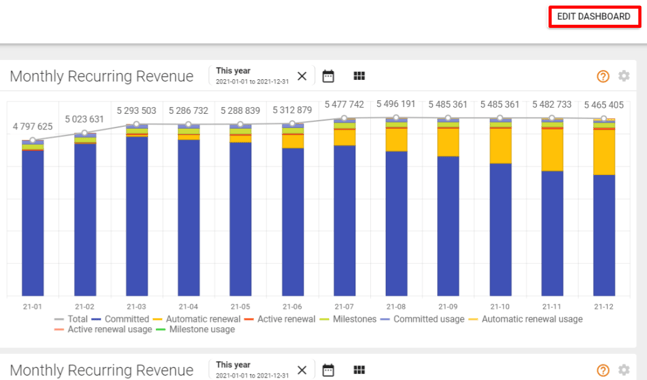
Image via Younium
Want to know the best part?
You can use these customisable reports to show your company’s investors how well you’re performing and how your business is growing.
Investors need regular updates on the company’s health, and these analytics reports can help you keep your investors at ease.
And if you need to bring in more investments, showing all the company’s accurate performance analytics on a single platform definitely helps.
You May Also Like:
- Subscription Metrics Part 1: Recurring Revenue in B2B
- Subscription Metrics Part 2: Difference between MRR & CMRR?
4. Multiple Payment Options
This is another one of the must-have subscription management software features that can’t be ignored. This is especially useful for optimising your financial workflow.
Your subscription management solution should be able to accept multiple payment gateways and options including credit cards, wallets, bank transfers, checks, invoices, etc.
Why is it important?
It makes it easier for customers to make payments according to their convenience and that reduces abandoned cart incidents.
It should also accept payments in different currencies as that would allow you to cater to customers around the world.
Another feature related to payments is automatic and accurate tax calculations. We’ll cover it in the next section.
5. Tax Compliance
One of the subscription management software features that enable smooth payments is automatic tax calculation. A good software solution should be able to calculate taxes in compliance with different tax regulations.
If you want a smooth workflow, your subscription management software solution should be able to automatically calculate taxes during the checkout process.
So, look for a software solution that specifically mentions tax compliance and calculation as one of its features. If it’s not explicitly mentioned as a feature, chances are that the software solution is not tax-compliant.
Younium, for example, offers a tax-compliant solution for B2B businesses and explicitly mentions it on the website.
It offers customisable tax templates wherein you can add a list of countries where you conduct business and their tax rates and regulations. Once you feed in the data, the platform will automatically calculate taxes for clients from different countries based on the guidelines.

Image via Younium
You May Also Like:
- Ensuring Data Security Standards: Younium Achieves SOC 2 Compliance
- What to know about US Sales Tax as a SaaS Company
6. Notifications/Reminders
One of the features that you definitely want in your subscription management software solution is the ability to send automatic notifications, alerts, and reminders.
From the moment a customer makes a purchase and throughout their association with your business, you need to keep them updated about important events.
For example, you should send a welcome email as soon as they sign up. You will also need to send payment reminders when the billing date is coming close.
Sending timely invoice reminders is especially important for B2B businesses as they mostly work on deferred payments.
So, when choosing SaaS subscription management software, always look for features that enable automated alerts.
7. Customised Customer Portal
Every SaaS subscription management software solution should have a dedicated customer portal. It’s where your customers can get all the information about their plans and can modify it if they want.
It should also contain all details on their bills, invoices, and other pertinent information. This enables you to maintain complete transparency.
What’s even better is that some software solutions allow you to use your branding for the customer portal. So, your customers can acquire all the information and make changes to their plans without leaving your brand environment.
8. Multiple Integration Options
Last on our list of SaaS subscription management software features is the ability to integrate with other tools and platforms.
As a SaaS business, you need a single source of truth for all your business data. If your subscription management system can integrate with other systems, such as CRM software, accounting software, ERP systems, and financial software, you can access all data from one place.
Moreover, integrations allow you to create a streamlined data flow involving many systems working in sync. This will also improve your operational efficiency and ensure that processes work smoothly, without interruptions and data leakage.
So, the more systems your software can integrate with, the better. Younium, for instance, allows you to connect multiple systems using connectors and APIs.
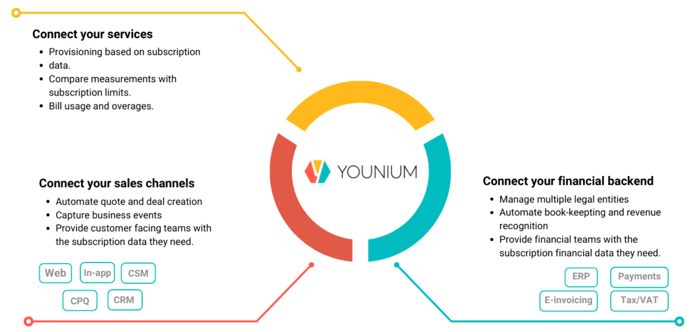
Image via Younium
Invest in a B2B subscription management hub that allows seamless integration with your existing tech stack. Specifically, check for integrations with specific tools that you’re currently using to ensure any discrepancies later on.
9. Security Features
Subscription management platforms handle a lot of customer data, including personal or confidential information. That’s why you should choose a subscription management platform that offers robust security features.
Here are some of the many information security features offered by Younium:
- Multifactor Authentication: Users are required to complete two or more levels of authentication before logging in, which provides an extra layer of security.
- Single Sign-On (SSO): It allows users to sign in once to access various accounts and applications. This reduces password fatigue and instances of using weak or repetitive passwords.
- Regular Security Audits: Younium conducts frequent security checks to ensure its platform and all customer data are 100% secure. Regular audits help identify potential security issues and fix them before they become a problem.
- Data Encryption: Younium encrypts all data, whether stored or while being transferred, to ensure complete data integrity and security.
- Compliance with Regulations: Following industry-specific security standards is a must and Younium understands that. It follows all important security standards, such as SOC 2, and adheres to their guidelines to offer robust data protection and security to its clients.
Data security is an important factor you should consider when choosing subscription management solutions.
You May Also Like:
- Why subscription management leads to efficient management
- How Efficient Subscription Management Enables Accurate Revenue Forecasting
FAQs
1. What are subscription businesses?A subscription business does not sell a one-time product or service, but a subscription that gets recurring revenue. For example, instead of a customer paying for a product to buy it, they can buy a subscription to use a product for a certain period of time.
Subscription businesses can sell physical products, digital products, or even services. As long as the customers subscribe to a plan and do not make just a one-time purchase, it is a subscription business.
2. What is subscription management software?These are software that help manage all aspects of a subscription business from revenue recognition to automated recurring billing and online payments.
Such software solutions have features designed specifically for subscription businesses that deal with recurring revenue instead of one-time payments.
Given the complexity of subscription businesses, using a subscription management platform is a must. These platforms automate and streamline a lot of tedious tasks to make things simpler for subscription businesses.
3. What are the most important subscription management software features?Here are the most important SaaS subscription management software features to look for when selecting one for your business:
- Flexible recurring billing options
- Advanced invoicing
- Customisable analytics reports
- Easy checkout
- Multiple payment options
- Tax compliance
- Notifications/reminders
- Customer portal
- Multiple integration options
- Robust security features
When comparing options on various subscription management software features, ensure that you also consider your organisational requirements and budget. These are also important considerations in making an informed decision, so don’t just rely of a list of software management software features.
4. What billing features should subscription management software have?
One of the most important SaaS subscription management software features is automated recurring billing. But to manage that effectively, it needs to be able to handle:
- Different pricing models like flat usage-based pricing and tiered pricing
- Complex scenarios that need calculations and adjustments like prorations and grandfathering
When looking for recurring billing features, always compare the detailed functionalities offered by each subscription billing system to make the right choice.
5. What are the benefits of subscription management software?Here are some key benefits of subscription management software:
- Automates billing, invoicing, payments, and tax calculations to save time and reduce the scope for error
- Improves data tracking and analytics to aid business decisions
- Integrates with other tools to provide a single source of truth for all your business data
- Meets tax compliance requirements by doing accurate and automatic tax calculations when accepting payments
- Helps avoid revenue leakage and enables advanced revenue recognition
But to realise all these benefits you need to choose a SaaS subscription management software solution with the right set of features. The ability to handle different billing scenarios, automatic invoicing, and in-depth analytics are some subscription management software features you should look for.
6. Why is subscription management important for SaaS businesses?
SaaS businesses thrive on recurring revenue. Effective subscription management reduces churn, improves cash flow, and ensures smooth operations as your customer base grows. It also helps you adapt to complex contract structures, billing rules, and compliance needs like IFRS 15 and ASC 606.
7. How does Younium support subscription management?
Younium is a finance-grade subscription management platform built for B2B SaaS businesses. It goes beyond basic billing to cover the full quote-to-cash lifecycle — including amendments, price changes, credit memos, and revenue recognition — all in a single, unified system.
8. What sets Younium apart from other subscription management tools?
While most tools offer point solutions or limited billing automation, Younium combines CPQ, billing, revenue recognition, and financial reporting in one scalable platform. It’s designed to support complex SaaS contracts and real-time decision-making across sales, finance, and operations.
9. Does Younium support hybrid growth models like PLG and SLG?
Yes. Younium supports Sales-Led Growth (SLG), Product-Led Growth (PLG), Partner-Led, and Online Self-Serve models — all in one platform. Whether you're scaling through enterprise sales, freemium-to-paid, or channel partnerships, Younium adapts to your growth motion with ease.
10. Is Younium suitable for businesses with usage-based pricing?
Absolutely. Younium natively supports usage-based, tiered, volume, and milestone-based billing models. You can track consumption, calculate charges, and generate accurate invoices — all without workarounds or custom scripting.
11. How does Younium help with revenue recognition and compliance?
Younium automates revenue recognition according to IFRS 15 and ASC 606. It handles line-item level deferrals, allocations, and recognitions — helping finance teams stay audit-ready while eliminating manual spreadsheets.
12. Who should consider using Younium?
If you're a scaling B2B SaaS business with recurring or usage-based revenue models, complex billing rules, or hybrid sales motions — Younium is your ideal subscription and revenue management platform. It helps you streamline operations, stay compliant, and scale efficiently.
10. What are the best subscription management software platforms in 2025? Some of the most widely used and trusted solutions include:
- Younium – best for B2B SaaS, complex billing, and full quote-to-cash lifecycle
- Chargebee – popular among growing startups, B2C and PLG companies
- Recurly – optimized for digital content and media businesses
- Stripe Billing – best for small simple subscription business
Conclusion
Subscription management software solutions are necessary if you run a subscription business, but they’re only effective if they have the right set of features.
What are the right subscription management software features?
Well. that depends on your business needs and requirements. Still, we’ve made a list of the top must-have features that you should consider when making a selection.
You should go through these features and prioritise them according to your needs and then use the final list to choose the right subscription management hub for your business.
Younium offers all the subscription management software features you’ll need to run a successful SaaS business. Book a demo to test its features and user interface and decide if it’s the right choice for you.